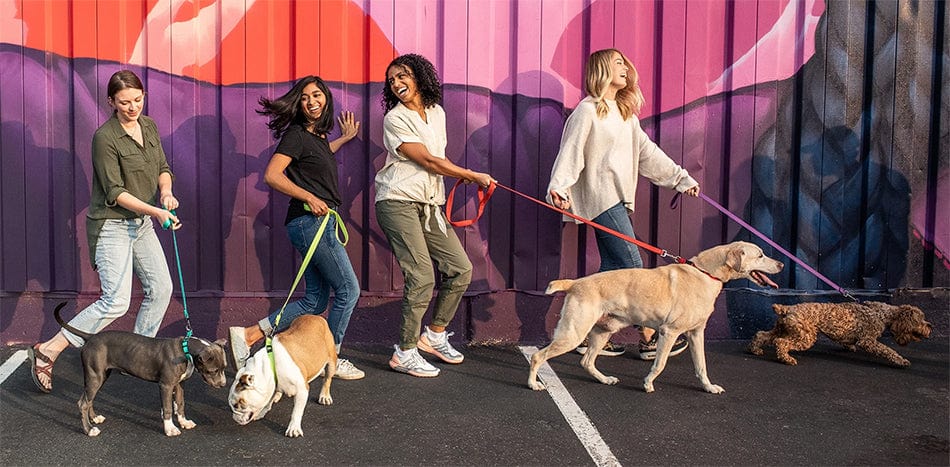Your cart is empty. Let's fix that!


Between snowstorms and calorie-rich holiday treats, we’re all prone to packing on a few extra pounds in winter—your pets included! Here’s how to help your pet stay healthy and active all winter long.
We start every winter with the best of intentions, planning beautiful snowy hikes and picking out cozy pet jackets for them to wear on afternoon walks! And then somehow we end up cuddled up on the couch with them every Saturday afternoon, indulging in junk food and a Netflix marathon.
We get it—it’s no fun to take your daily walk in slippery slush or dodging hidden ice. Even playing inside feels less appealing when you’d rather be glued to your heating pad (if you can get your pets off it, that is).
If that sounds like you too, you’re not alone. A little weight gain is extremely common for pets and people in the winter, and it’s nothing to feel guilty about. Instead, focus on the benefits of getting your pets into shape: more healthy, happy years with you!
Being overweight or obese can put your pets at risk of developing a whole range of health issues from joint pain to life-threatening diseases. While it’s okay to hunker down for winter a little bit, your pet still needs to get good nutrition and a healthy amount of exercise to keep them feeling good.
Whether you have an already overweight cat or dog or you’re trying to keep your couch potato active through the winter, there are easy ways to make healthy lifestyle adjustments for your best friend.
Depending on the climate where you live, winters can be brutal. Whether you’re contending with chilly rain, unpredictable snow, or all-out ice storms, the outdoors feels a little less friendly in the winter months. Plus, days are shorter and your normal evening walk around the block is less fun when 5 PM feels like midnight!
The key to enjoying your time outdoors is to work with winter instead of against it! Plan your walks for the middle of the day when the sun and temperatures are at their highest and avoid the frigid mornings and evenings. Be as flexible as you can and take the opportunities to hit the dog park as they come between snow squalls.
Don’t be afraid to scale back on plans, either. Instead of abandoning your outdoor time entirely when your car is buried under snow, settle for a game of snowball fetch in the backyard or some time playing in the catio.
Wherever you go, make sure you and your pet are well-prepared for the outdoors! Your pet might benefit from a jacket or booties so they can stay comfortable in the cold for longer. Make sure you keep an eye on the weather and don’t keep your pets outside too long in the cold, especially if temperatures are dangerously low.
While physical activity is key for helping your pet to shed excess weight, getting outdoors has the added bonus of boosting serotonin and helping you and your pet fight the winter blues!
Outdoor activities aren’t the only way to exercise your pet’s body and mind! You can keep them entertained (and building muscle mass) with indoor playtime and activities which can be just as rewarding as a vigorous romp outside.
Pet enrichment activities range from a classic game of tug-of-war or chase-the-string to puzzles for your pets to solve! Experiment to find the games and toys that really tickle your pet’s fancy, and soon they’ll be begging for another session with the snuffle mat. Here are some of our favorite enrichment activities for cats and dogs to get you started!
You can also consider playtime options outside your home! Look into local doggy daycares, agility training courses, and other similar facilities to find somewhere with ample space for your dog to get their zoomies out without having to step a paw in the snow.
If your pet is getting a little chonky, it’s easy to think that the solution is just to start serving up less food for dinner—fewer calories equals weight loss, right? Well, not quite. Pet nutrition is complex, and it’s about more than just reducing body weight. Body composition is just as important, and if you start feeding your pet less than recommended, they’ll also be losing out on protein for their muscle health as well as other key nutrients.
With that being said, you should be sure that you’re not overfeeding your pet! Take a closer look at the feeding guidelines of your current pet food. Are you serving up the recommended portion size for your pet? Think about how many treats (especially human food!) you feed your pet in a day. Vets say that it’s okay for about 10% of your pet’s daily calories to come from treats, but if it creeps above that, it’s time to cut back.
If you’re following all the guidelines and your pet is still above a healthy weight, consult with your veterinarian about how to safely restrict calories. Our on-staff holistic veterinarian is a big fan of food formulas that cut calories while still being rich in protein and nutrients, like this reduced-calorie kibble designed to help sedentary indoor cats lose weight!
It can be tempting to go big when you’re starting a new weight loss journey, but that usually doesn’t work out for the best. There’s a reason that crash diets typically fail and why you shouldn’t go too hard your first day at the gym—it feels bad, and it’s not good for your body! Healthy weight loss is all about slow and steady progress, and that is especially true for pets.
Overweight pets should gradually lose a small amount of weight per week—about 1-2% of a dog’s body weight or 0.5-2% of a cat’s body weight. If you do the math, that means that a 100 pound dog can safely lose 1 to 2 pounds per week, but a 20 pound cat should only lose 0.2-0.4 pounds per week (that’s just 4 oz)! Losing weight any faster can actually harm their health, so take things nice and easy.
Similarly, you don’t want to hit exercise too hard and fast either! A walk that’s twice as long as your pet is used to will probably leave you both too sore to leave the couch the next day. Start by exercising consistently at a level your pet is comfortable with and slowly add time and intensity bit by bit to build up their strength and endurance. You have to cater the intensity to your pet, too—a high-energy cattle dog is naturally well-suited to long, fast runs, while a snuffly little pug deserves a gold star for adding another go around the block to their daily routine.
Check out our tips on how to take you and your dog from the couch to a 5K together for more advice on safely and slowly building up your pet’s fitness!
In our experience, the best way to get your pet excited to move and be active is to be involved in the process with them! Nobody likes to do something difficult alone, and you can offer your pet more moral support than anyone else in the world. Buying puzzle toys and automated laser pointers is great, but engaging with your pet is what will make the activity the most tempting and rewarding for your pet and you as you build their health and your relationship.
You and your pet have each other’s backs, and finding a balance of couch cuddle sessions and vigorous play times will leave your pet trim, healthy, and happy when springtime rolls around!